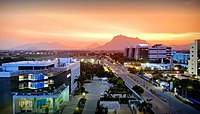
Photo from wikipedia
Abstract The combination of heat waves and urban heat “island” (UHI) and “archipelago” (UHA) effects can adversely impact the health of city residents. These impacts could be amplified in the… Click to show full abstract
Abstract The combination of heat waves and urban heat “island” (UHI) and “archipelago” (UHA) effects can adversely impact the health of city residents. These impacts could be amplified in the future, with low-income communities most affected, and neighborhood-scale temperature data provide essential information for adaptation. In recent years, fixed and mobile sensor approaches are widely used for intra-urban temperature monitoring. However, empirical studies comparing these two approaches and investigating how network designs can affect the information collected remain limited. This study analyzes temperature data collected by the two monitoring approaches in Baltimore, MD to address representation of spatio-temporal temperature variability within a city and to investigate the sensor distribution strategy that most efficiently capture the UHA. We find that: (1) vehicle-based mobile monitoring with only on-street data does not capture the full range of urban thermal environments; (2) the sampling bias of vehicle-based monitoring results in lower predictive accuracy for unmonitored locations under hot afternoon conditions; (3) single-event measurement campaigns on “hot” days do not capture spatial temperature variations observed for non-hot days; (4) the efficiency of a fixed sensor network can be significantly increased through appropriate designs. Each of these findings is important for improving future intra-urban temperature monitoring activities.
Journal Title: Urban Climate
Year Published: 2021
Link to full text (if available)
Share on Social Media: Sign Up to like & get
recommendations!